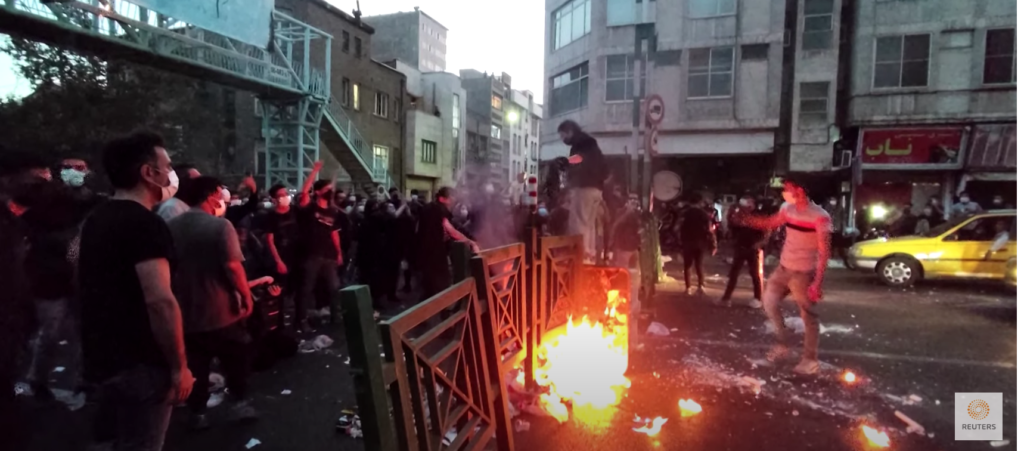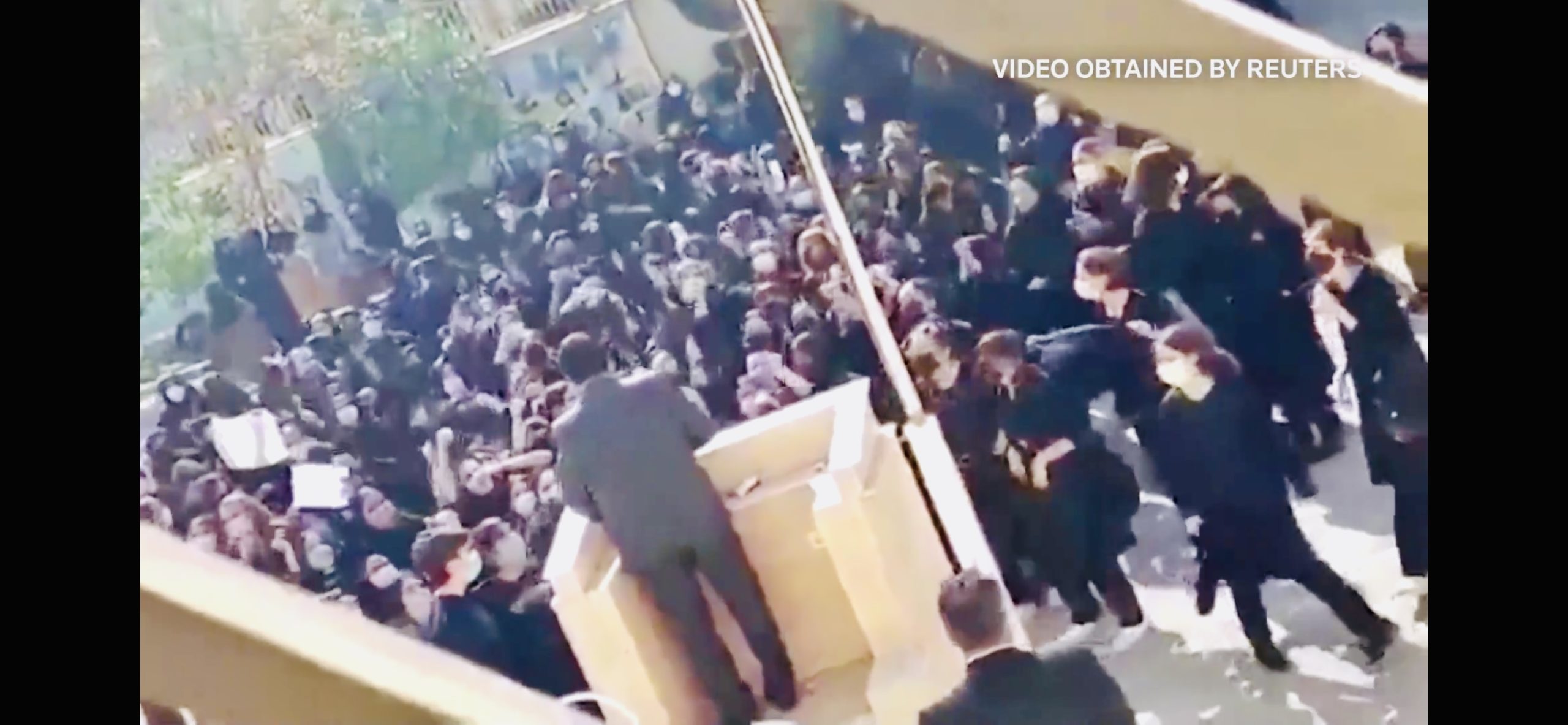On September 16, Mahsa Amini, a 22-year-old Iranian woman, died in the custody of morality police while visiting relatives in Tehran. Eyewitnesses report Amini was brutally beaten into a coma by law enforcement and forcefully detained in the back of a police van for the improper wearing of a hijab and clothing. CNN reported that Iranian officials contend Amini died of a heart attack, yet her family members insist she had no pre-existing heart condition.
The killing has sparked months of protests and unrest. On Dec. 8, one of the protestors was hanged by government officials in retaliation. On Monday, Dec. 12, the Islamic Republic hanged a second protestor in public. Meanwhile, there are unconfirmed reports that the country’s morality police is being disbanded.
Iran’s morality police, which serves under the country’s Law Enforcement Forces, focuses on the inappropriate wearing of hijabs and other clothing articles along with censoring various freedoms of expression. Veil regulations and requirements derive from the Iranian regime that came to power after the Iranian Revolution in 1979, and since then has demanded all women ages 9 and older wear a hijab in public.
Iran’s Islamic Penal Code reads as follows: “Women, who appear in public places and roads without wearing an Islamic hijab, shall be sentenced to ten days to two months’ imprisonment or a fine of fifty thousand to five hundred [thousand] Rials,” (Article 638). The article also authorizes a sentence of “two months in prison or up to 74 lashes” for “[anyone] who openly commits a harām (sinful) act, in addition to the punishment provided for the act.”
The U.S. State Department condemned the killing. In a statement, Secretary of State Anthony Blinken said, “We mourn with her loved ones and with the Iranian people. In response to this and other human rights violations in Iran—including the violent suppression of peaceful protests—the United States is imposing sanctions on Iran’s Morality Police and senior security officials who have engaged in serious human rights abuses, pursuant to Executive Order 13553.”
After Mahsa Amini’s tragic death, ongoing protests bearing the slogan “Women, Life, and Freedom” began to take place. Many women of all ages shed their heads of their hijabs in solidarity and burned them while calling for reforms and the immediate destruction of the Iranian morality police, a goal that female activists have been fighting towards since its establishment. Protests have continued for weeks, spreading throughout all 31 provinces of Iran, 105 cities, and 69 major universities.
BBC reports that the ongoing protests have not only included the older generation, but also schoolgirls who are removing their headscarves in public and burning pictures of Ayatollah Khamenei, the current supreme ruler of Iran and most powerful man in the entire country, along with Ayatollah Ruhollah Khomeini, the founder of the Republic of Iran, as an act of rebellion. This emerging generation of women is powerful and will not stand to be subjected to the same mistreatment and heinous abuse their mothers and grandmothers faced. All classes and categories of minorities and majorities both ethnically and economically of Iran have unified under this one human rights issue, even while lacking a headstrong leadership or vast organization, to attain the ability to choose and express.
In response to the emerging protests, police brutality continues. Reuters reported on Nov. 22 that over 300 protesters have now been killed, including more than 40 minors and on Nov. 17 reported that more than 16,000 people have been arrested. The Iranian forces have arrested both reporters and political organizers as well as using live ammunition, tear gas, and sound bombs to clear the masses. According to Politico, the Committee to Protect Journalists has reported that Iranian forces, in an effort to limit the freedoms of the press, have detained at least 40 journalists. An article by the Washington Post states that Iranian authorities have played off the recent protests as a conniving Western scheme, going as far as to shut down and block the internet in parts of the country. The Iranian government meanwhile, continues to brush off accusations of human rights violations. The Human Rights Activists News Agency (or HRANA) reports that the Iranian Medical Forensic Organization published its pathology tests on Mahsa Amini stating, “her death was not caused by blow to the heads or any vital organs and parts of the body” while family members report seeing large wounds on Mahsa’s face and legs as she laid in a coma before her death.

Recent months have seen increases in the violence and terror Iranian women face. After Ebrahim Raisi assumed presidency last summer, he dedicated his administration to the enforcement of hijab laws and restrictions on the bodies of defiant women. American Muslim reports heightened levels of harrasment, assault, indictments, and prison sentences during his reign which sociologist, Azdeh Kian, describes as the “Talibanization of political power under Raisi.”
Accompanying stricter headscarf laws, United Nations human rights officials report that the summer of 2021 brought about a new law that critically restricted access to abortion and contraception services, a topic questioned and violated countless times in the recent years of bipartisan controversy. The Iranian government is no stranger to undervaluing and objectifying the existence of women. United Against Nuclear Iran, a website that tracks violence against women, highlights the legality of both marital rape and child marriages, along with domestic violence which is not a crime under Iranian law. Known as “honor killings,” these so called private family matters receive lighter penalties than other acts of murder.
Repressive policies of a woman’s privacy have begun appearing across the world in form of abusive laws and oppressive police forces. After recent restrictive abortion laws passed in both the US and Iran, it is imperative that the right to protest and freedom of expression be protected, a duty that has fallen rightfully and unrightfully onto every woman, man, and person alike.
As of December 4, 2022, USA Today reports that Iran’s Attorney General states that “[the morality police] have nothing to do with the judiciary and have been shut down” along with the promise that the decade-old hijab law would be reviewed and revised in a week or two. At the call of years of civilian action and months of defiance spreading into the limelight, the Iranian government answered in hopes to calm worries amid protests. And although it remains unclear as to the extent of the impending revisions and no clear changes have been cemented, the women of Iran could ultimately end up forcing the government to acknowledge their freedom of expression that has been the root of the fight for so long. However, that potential for success does not undermine the need for more and the struggle Iranian women will continue to face, from child marriages to “honor killings,” every day without continued action.




